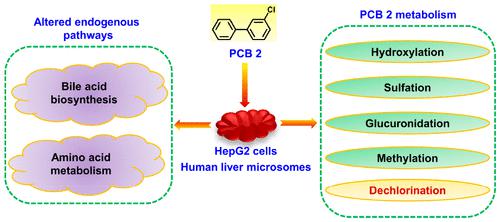当前位置:
X-MOL 学术
›
Environ. Sci. Technol.
›
论文详情
Our official English website, www.x-mol.net, welcomes your feedback! (Note: you will need to create a separate account there.)
Metabolism of 3-Chlorobiphenyl (PCB 2) in a Human-Relevant Cell Line: Evidence of Dechlorinated Metabolites
Environmental Science & Technology ( IF 10.8 ) Pub Date : 2022-08-22 , DOI: 10.1021/acs.est.2c03687 Chun-Yun Zhang 1, 2 , Xueshu Li 2 , Susanne Flor 2 , Patricia Ruiz 3 , Anneli Kruve 4 , Gabriele Ludewig 2 , Hans-Joachim Lehmler 2
Environmental Science & Technology ( IF 10.8 ) Pub Date : 2022-08-22 , DOI: 10.1021/acs.est.2c03687 Chun-Yun Zhang 1, 2 , Xueshu Li 2 , Susanne Flor 2 , Patricia Ruiz 3 , Anneli Kruve 4 , Gabriele Ludewig 2 , Hans-Joachim Lehmler 2
Affiliation

|
Lower chlorinated polychlorinated biphenyls (LC-PCBs) and their metabolites make up a class of environmental pollutants implicated in a range of adverse outcomes in humans; however, the metabolism of LC-PCBs in human models has received little attention. Here we characterize the metabolism of PCB 2 (3-chlorobiphenyl), an environmentally relevant LC-PCB congener, in HepG2 cells with in silico prediction and nontarget high-resolution mass spectrometry. Twenty PCB 2 metabolites belonging to 13 metabolite classes, including five dechlorinated metabolite classes, were identified in the cell culture media from HepG2 cells exposed for 24 h to 10 μM or 3.6 nM PCB 2. The PCB 2 metabolite profiles differed from the monochlorinated metabolite profiles identified in samples from an earlier study with PCB 11 (3,3′-dichlorobiphenyl) under identical experimental conditions. A dechlorinated dihydroxylated metabolite was also detected in human liver microsomal incubations with monohydroxylated PCB 2 metabolites but not PCB 2. These findings demonstrate that the metabolism of LC-PCBs in human-relevant models involves the formation of dechlorination products. In addition, untargeted metabolomic analyses revealed an altered bile acid biosynthesis in HepG2 cells. Our results indicate the need to study the disposition and toxicity of complex PCB 2 metabolites, including novel dechlorinated metabolites, in human-relevant models.
中文翻译:

3-氯联苯 (PCB 2) 在人类相关细胞系中的代谢:脱氯代谢物的证据
低氯多氯联苯 (LC-PCB) 及其代谢物构成一类环境污染物,会对人类造成一系列不良后果;然而,LC-PCBs 在人体模型中的代谢很少受到关注。在这里,我们表征了 PCB 2(3-氯联苯)的代谢,这是一种与环境相关的 LC-PCB 同系物,在 HepG2 细胞中具有计算机模拟预测和非目标高分辨率质谱。在暴露于 10 μM 或 3.6 nM PCB 2 24 小时的 HepG2 细胞的细胞培养基中鉴定出属于 13 类代谢物的 20 种 PCB 2 代谢物,包括五种脱氯代谢物类。PCB 2 代谢物谱不同于单氯代谢物谱在相同实验条件下使用 PCB 11(3,3'-二氯联苯)进行的一项早期研究的样本中发现。在与单羟基化 PCB 2 代谢物而非 PCB 2 孵育的人肝微粒体中也检测到了脱氯二羟基化代谢物。这些发现表明,LC-PCB 在人类相关模型中的代谢涉及脱氯产物的形成。此外,非靶向代谢组学分析揭示了 HepG2 细胞中胆汁酸生物合成的改变。我们的结果表明需要在人体相关模型中研究复杂 PCB 2 代谢物(包括新型脱氯代谢物)的处置和毒性。
更新日期:2022-08-22
中文翻译:

3-氯联苯 (PCB 2) 在人类相关细胞系中的代谢:脱氯代谢物的证据
低氯多氯联苯 (LC-PCB) 及其代谢物构成一类环境污染物,会对人类造成一系列不良后果;然而,LC-PCBs 在人体模型中的代谢很少受到关注。在这里,我们表征了 PCB 2(3-氯联苯)的代谢,这是一种与环境相关的 LC-PCB 同系物,在 HepG2 细胞中具有计算机模拟预测和非目标高分辨率质谱。在暴露于 10 μM 或 3.6 nM PCB 2 24 小时的 HepG2 细胞的细胞培养基中鉴定出属于 13 类代谢物的 20 种 PCB 2 代谢物,包括五种脱氯代谢物类。PCB 2 代谢物谱不同于单氯代谢物谱在相同实验条件下使用 PCB 11(3,3'-二氯联苯)进行的一项早期研究的样本中发现。在与单羟基化 PCB 2 代谢物而非 PCB 2 孵育的人肝微粒体中也检测到了脱氯二羟基化代谢物。这些发现表明,LC-PCB 在人类相关模型中的代谢涉及脱氯产物的形成。此外,非靶向代谢组学分析揭示了 HepG2 细胞中胆汁酸生物合成的改变。我们的结果表明需要在人体相关模型中研究复杂 PCB 2 代谢物(包括新型脱氯代谢物)的处置和毒性。
















































 京公网安备 11010802027423号
京公网安备 11010802027423号